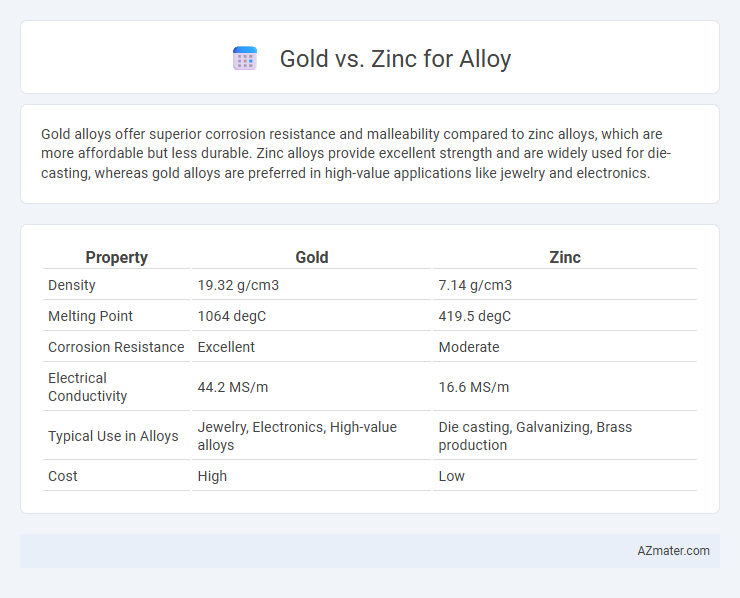Gold alloys offer superior corrosion resistance and malleability compared to zinc alloys, which are more affordable but less durable. Zinc alloys provide excellent strength and are widely used for die-casting, whereas gold alloys are preferred in high-value applications like jewelry and electronics.
Table of Comparison
| Property | Gold | Zinc |
|---|---|---|
| Density | 19.32 g/cm3 | 7.14 g/cm3 |
| Melting Point | 1064 degC | 419.5 degC |
| Corrosion Resistance | Excellent | Moderate |
| Electrical Conductivity | 44.2 MS/m | 16.6 MS/m |
| Typical Use in Alloys | Jewelry, Electronics, High-value alloys | Die casting, Galvanizing, Brass production |
| Cost | High | Low |
Introduction to Alloying: Gold vs Zinc
Gold and zinc serve distinct purposes in alloying due to their differing chemical and physical properties. Gold enhances corrosion resistance and adds ductility when alloyed, making it ideal for jewelry and electronics, while zinc primarily acts as a strengthening agent in alloys like brass and solder, improving hardness and castability. Understanding the roles of gold and zinc helps optimize alloy composition for targeted mechanical performance and durability.
Chemical Properties: Gold and Zinc Explained
Gold exhibits remarkable chemical stability due to its inertness and resistance to oxidation, making it ideal for alloys requiring corrosion resistance. Zinc, characterized by its moderate reactivity and ability to form stable compounds, acts as a durable component in alloys that enhance strength and corrosion protection. When combined, gold and zinc create alloys leveraging gold's non-reactivity and zinc's protective properties, optimizing chemical durability and mechanical performance.
Alloy Formation: Mechanisms of Gold and Zinc
Gold and zinc form alloys primarily through substitutional and interstitial mechanisms, where zinc atoms integrate into the gold lattice, altering its physical and chemical properties. The atomic size difference between gold (144 pm) and zinc (134 pm) influences the extent of lattice distortion and solid solution formation, impacting the alloy's hardness and corrosion resistance. The electron configuration and electronegativity differences contribute to phase stability and intermetallic compound formation, critical for tailoring alloy characteristics in various industrial applications.
Strength and Durability: Performance Comparison
Gold-zinc alloys exhibit enhanced strength and durability compared to pure gold, making them suitable for applications demanding higher mechanical performance. The addition of zinc increases hardness and resistance to deformation without significantly compromising gold's corrosion resistance. This balance makes gold-zinc alloys ideal for jewelry and industrial components requiring both aesthetic appeal and structural resilience.
Cost Analysis: Gold vs Zinc in Alloys
Gold alloys typically incur significantly higher costs compared to zinc alloys due to gold's rarity and market value, making gold alloys more suitable for luxury applications. Zinc alloys offer a cost-effective alternative with good mechanical properties, often used in automotive and construction industries requiring economical mass production. The price disparity directly impacts material selection, where zinc alloys optimize budget without compromising performance, whereas gold alloys prioritize aesthetic and corrosion resistance in high-end products.
Corrosion Resistance: Gold and Zinc Alloys
Gold alloys exhibit superior corrosion resistance due to gold's inertness, making them ideal for environments exposed to moisture and chemicals. Zinc alloys, while less resistant to corrosion, often include protective coatings or are combined with other metals to enhance durability in industrial applications. The inherent non-reactive nature of gold provides a significant advantage in preventing oxidation compared to zinc-based alloys.
Applications in Industry: Gold versus Zinc Alloys
Gold alloys are extensively used in the electronics and dental industries due to their excellent conductivity, corrosion resistance, and biocompatibility, making them ideal for precision components and dental restorations. Zinc alloys find broader applications in die-casting for automotive parts, consumer electronics housings, and hardware due to their strength, low cost, and ease of manufacturing. Industrial applications favor gold alloys when durability and electrical performance are critical, whereas zinc alloys are preferred for structural and decorative components requiring cost efficiency and moderate mechanical strength.
Aesthetic Qualities: Visual Appeal and Use Cases
Gold alloys exhibit a rich, warm luster with yellow, rose, or white tones, enhancing the aesthetic appeal of jewelry and luxury items due to their high reflectivity and resistance to tarnish. Zinc alloys offer a more muted finish with a silvery-gray appearance, often used in decorative hardware and large-scale sculptures where cost-effectiveness and durability are prioritized over brilliance. The choice between gold and zinc alloys depends on the desired visual impact, with gold favored for premium, eye-catching designs and zinc chosen for practical, less expensive applications.
Environmental Impact: Gold vs Zinc Extraction
Gold extraction typically involves toxic chemicals like cyanide and mercury, resulting in significant environmental contamination, habitat destruction, and water pollution. Zinc extraction uses less harmful methods such as flotation and roasting, producing lower levels of hazardous waste and offering a more eco-friendly footprint. Consequently, zinc alloys generally present a reduced environmental impact compared to gold-based alloys, making zinc a more sustainable choice for metal production.
Future Trends in Alloy Development: Gold and Zinc
Gold-zinc alloys are gaining attention for their enhanced corrosion resistance and malleability, making them ideal for advanced electronics and medical implants. Emerging research focuses on optimizing gold-zinc ratios to improve conductivity and strength while reducing costs compared to pure gold alloys. Future trends emphasize sustainable extraction and recycling methods to meet growing demand in aerospace and wearable technology industries.

Infographic: Gold vs Zinc for Alloy
 azmater.com
azmater.com